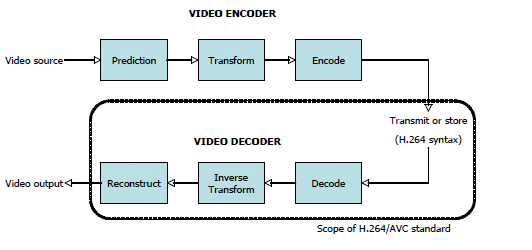H.264 Advanced Video Coding is an industry standard for video coding. Standardizing video compression makes it possible for products from different manufacturers such as encoders, decoders and storage media to inter-operate. An encoder converts video into a compressed format and a decoder converts compressed video back into an uncompressed format.
H.264 defines a syntax for compressed video and a method for decoding this syntax to produce a displayable video sequence. The standard document does not specify how to encode digital video. This is left to the manufacturer of a video encoder. In practice the encoder is likely to mirror the steps of the decoding process.
Encoding and Decoding Process
Below figure shows the encoding and decoding processes and highlights the parts that are covered by the H.264 standard. It builds on the concepts of earlier standards such as MPEG-2 and MPEG-4 Visual and offers the potential for better compression efficiency.

H.264/AVC describes a set of tools or methods for video compression. The standard specifies how video coded with these tools should be represented and decoded. A video encoder may choose which tools to use and how to apply them to the current video sequence, with some constraints. An H.264-compliant decoder must be capable of using a defined sub-set of tools, known as a profile.
An H.264 video encoder carries out prediction, transforming and encoding processes to produce a compressed H.264 bitstream. An H.264 video decoder carries out the
complementary processes of decoding, inverse transform and reconstruction to produce a decoded video sequence. The decoded version is, in general, not identical to the original sequence because H.264 is a lossy compression format.
